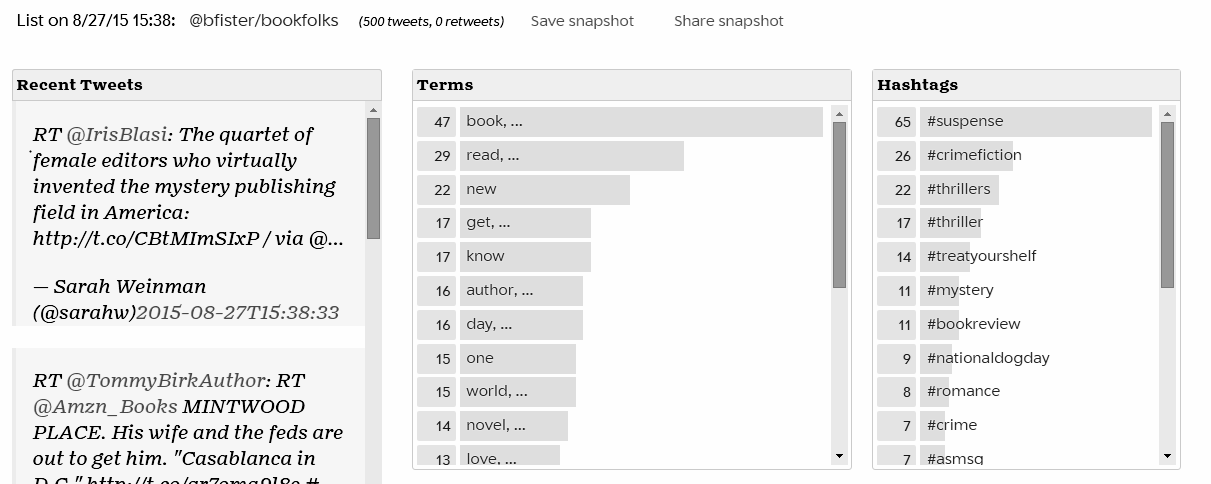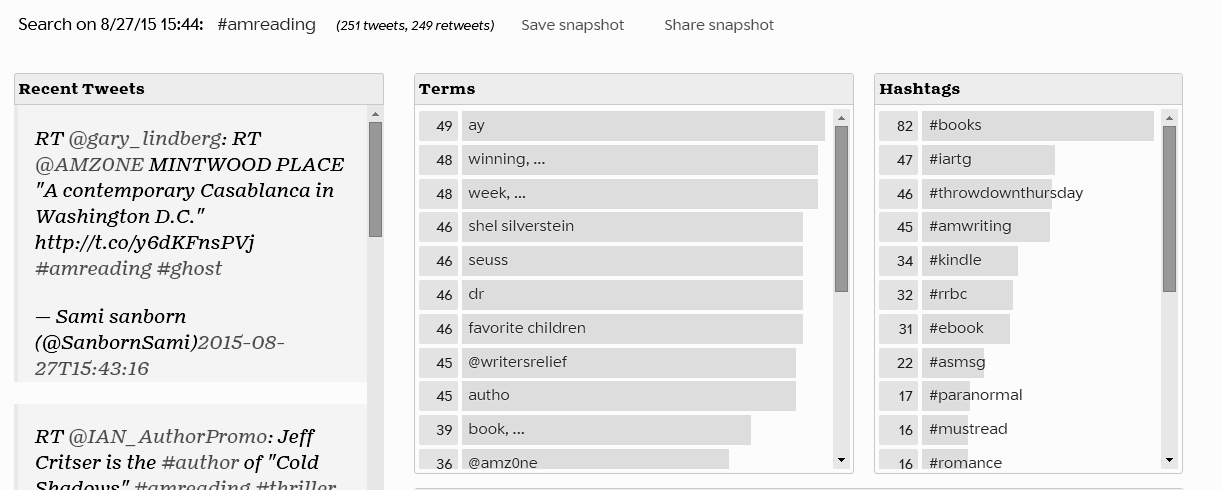Twitter is kind of hard to explain to those who don’t use it regularly. Originally described as a “micro-blogging platform,” it’s often dismissed as a trivial pursuit. How can you possibly say anything meaningful in 140 characters? Why do I care what somebody ate for breakfast? How does this thing even work? What a useless time-suck!
In fact, the criticisms of Twitter are very similar to those made of blogging when it was new and, later, of Facebook in the days before it became as ubiquitous as it now is. In the most recent social media update published by the Pew Internet project, 71 percent of American adults who go online use Facebook; nearly 60 percent of all American adults use Facebook. Twitter has an outsized media profile because of its immediacy, but a much smaller user base, with only 23 percent of adult Americans who use the internet signing up. For more than three-quarters of the population, Twitter remains either irrelevant or a puzzle – or both.
Though I created a Twitter account in 2008, I didn’t really get it. I learned how and why to use the platform while at a digital humanities THATCamp unconference in 2011. Attendees were encouraged to tweet about the concurrent sessions, and I quickly learned how to set up an application to watch several twitterstreams at once, including one from a university press conference happening at the same time. It was distracting and fast-paced, but amazingly fun and useful. Since then, most of the professional conferences I’ve attended have had a lively Twitter backchannel. At conferences, Twitter becomes my form of note-taking (at least if the wifi is able to handle the load; often it can’t.) At one conference I attended, a handful of us began to plan an unconference to address issues we wanted to explore further using Twitter, and that unconference actually happened as a result.
For me, Twitter is primarily as a serendipity engine, like browsing bookshelves or scanning an RSS feed. I follow around 500 people and organizations who share information that I find useful, often in the form of links. A majority of those I follow are librarians and academics, with a handful of journalists who cover things that interest me, as well as a smattering of people and groups who share my interest in crime fiction. Though I don’t even try to keep up with the flow, I check in daily and generally end up reading and saving links to news stories, scholarly papers, blog posts, or other resources that I may use later in research or teaching. Sometimes I engage in informal conversations, kicking an idea around with others. Sometimes I join scheduled chats about a topic of interest.
Twitter as a reading community platform
Twitter is a site where online reading communities form. It has hosted book clubs, as described by Anatoliy Gruzd and DeNel Rehberg Sedo in their article, “#1b1t: Investigating Reading Practices at the Turn of the Twenty-first Century.” Early Word (a site that informs public librarians about forthcoming books) hosts a monthly “galley chat” where librarians share their responses to advanced reader copies of forthcoming books that they’ve read and recommend. A popular hashtag is #fridayreads, used to share what the Twitter members are reading. This practice was kicked off by Bethanne Patrick, whose Twitter handle is @TheBookMaven. Another popular hashtag appended to book-related tweets is #amreading.
BookVibe is a service that mines and analyzes books mentioned in the tweets of people you follow and sends a weekly update of their recommendations. In part, this seems an exercise by an entrepreneurial group of computer scientists to develop ways of extracting information from tweets, but it’s interesting that the tech company decided to focus on books. In their “about” page, the challenge of sorting books from chaff is described this way:
. . . out of around 500 million tweets a day, traditional text matching search techniques would return around 10 million tweets a day that could be book titles, but the actual number of tweets about books is around 300,000 per day. Our technology handles these distinctions with very high precision.
The recommendations I get are a mixed bag, given the various interests of the people I follow, but they do tend to accurately identify books from the millions of short messages flowing constantly.
What does Twitter do for readers?
One of the things you can do on Twitter is create lists of Twitter accounts that you may not want to subscribe to, but will provide a site for serendipity when you want to see what a group is talking about right now. My Twitter account, for example, has been put on a number of lists other people have created, mostly library-related. I created a “bookfolks” list of fifty Twitter accounts that focus primarily on books and/or crime fiction. These range from tweets sent by Book Riot (a book-focused community website) and Shelf Awareness (a news service of sorts for independent booksellers and readers) to individual book bloggers or fans. Just to get a sense of whether my typical use of Twitter as a serendipity engine holds true for book-related tweets, I randomly chose a day to see what these fifty Twitter accounts send out within a twelve-hour period. It’s not scientific – I will leave such technicalities to computer scientists and digital wonks such as those at BookVibe.
Scanning through the tweets of fifty accounts for a 12-hour span on August 26th, I found that the largest number of tweets were links that led to book-related news or entertainment. The next largest category were promotional tweets – one account in particular was primarily devoted to promoting self-published thrillers, linking to Amazon pages; another, less active account pointed out items on the market for book collectors. There were also quite a few unrelated tweets – ones focused on current events or politics rather than on books. Twitter users typically have more than one interest and their Twitter streams reflect that, just as other online book discussions include a certain amount of “OT” (off topic) chatter. A smaller number linked to blog posts or to book reviews, with a smattering of tweets about book-related events, humorous quips about books and reading, inspirational quotations, or information about crime film or television dramas. While this breakdown is unlikely to be entirely typical, it mirrors my personal experience with Twitter. It is, above all, a site for sharing links to items of interest to one’s followers, with an admixture of links or comments on unfolding events. (In this time span, a particularly grisly crime was dominating cable news and leaking into this Twitter stream.) Some of the tweets had attracted comments and started conversations. John Scalzi, a science fiction author who is also an active blogger and Tweeter, had half a dozen comments on one of his tweets. But most of the tweets in this small sample were either posts without comments or retweets of other people’s tweets.
I also experimented with twXplorer, a tool developed by Knight Lab at Northwestern University, a non-profit organization that helps journalists use technology for reporting news stories. Using this tool, I was able to look at terms and hashtags used by accounts on my list and more broadly on Twitter, with terms and hashtags sorted for up to the most recent 500 tweets. twXplorer also finds links that turn up repeatedly, but my searches didn’t produce any common links. This is likely a more useful feature for journalists following breaking news stories. The three analyses I ran were of the list, the hashtag #amreading, and the hashtag #mysteries.
#community
Twitter is a platform that encourages a new kind of online community, one based on affinity and interlocking interests (and, admittedly, for marketing), with a tendency to lead participants away from the platform to follow links to other sites. At times, it generates conversations that can involve multiple people and dozens of tweets, but following conversations can be tricky. It’s often used to host scheduled chats, with rapid-fire short messages posted to respond to prompts or simply conversing on a common topic for a designated hour. It is used by authors as a promotional platform, though (as in other media) the authors who engage in authentic communication with readers are far more likely to gain a following than tweets that simply lead to an Amazon sales page. There are also informal but regular sharing of reading experiences using tags such as #fridayreads or #amreading. Readers, writers, libraries, bookstores, and publishers use Twitter for engagement.
The Ferguson (Missouri) Public Library, which gained an international audience of followers in the wake of Michael Brown’s death and the #BlackLivesMatter protests that followed, does a particularly fine job of engaging readers with prompts like “What is the best basketball book ever?” and “what fictional character is most like you? In what way?” All of the responses are retweeted, widening the circle of participants and creating a sense of community that expands well beyond the library’s service area. Scotty Bonner, the director of this small public library, is unusually proficient at using technology in innovative ways and gained an unusually large following in part because of being in the national eye, even participating in a Reddit “Ask Me Anything,” a signal achievement for tech-oriented people. This one small library provides an example of how individuals and book-related enterprises use Twitter in ways that create community around books, even within the platform’s 140-character limit.



